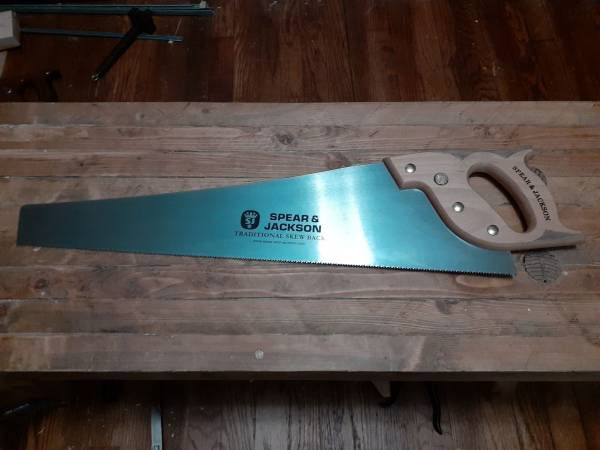
What I already had (the pencil-shaded areas are coming off)
*Good Hand Saws For Cheap...*
By: GVI
30 March 2023
Spear & Jackson is a hand tool manufacturer formerly in Sheffield, England but is now making tools in Taiwan. They've been in continuous business since the 1700s and made their reputation on saws, in much the same way Henry Disston did in the United States.
Spear & Jackson saws made nowadays are inferior to those from the early 20th century and before. It's not the fault of the Taiwanese; Sheffield steel isn't what it once was, and the newest version of the saws you see pictured are in fact identical copies of the British firm's last products before they started jobbing the work out overseas. In other words, this is what a British saw looked like in the 1980s.
I'm bringing this saw up because a tenon saw from them just arrived. It complements a panel saw of theirs which I got a few weeks ago. They both cost around $30-$40.

What I already had (the pencil-shaded areas are coming off)
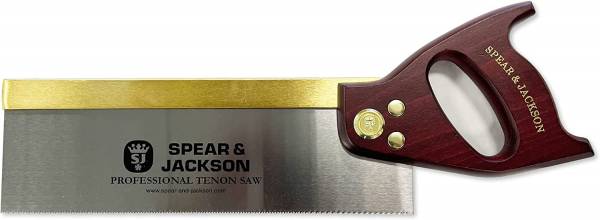
What just arrived
They're inexpensive, but that's not the same thing as saying they're cheap. In addition to their low cost, they have potential, and two people I pay attention to have tutorials on how to unlock this potential.
These two people are Paul Sellers and Rex Kruger. Sellers shows how to re-profile the grip of the larger saw, and Kruger shows the same for the tenon saw, as well as showing how to tune up the saw's plate.
The two videos made me wonder why Spear & Jackson made their handles the way they did - big, clunky and ugly. I really began wondering when I was at "Colonial Homestead" the other day, hefting a vintage Spear & Jackson saw...
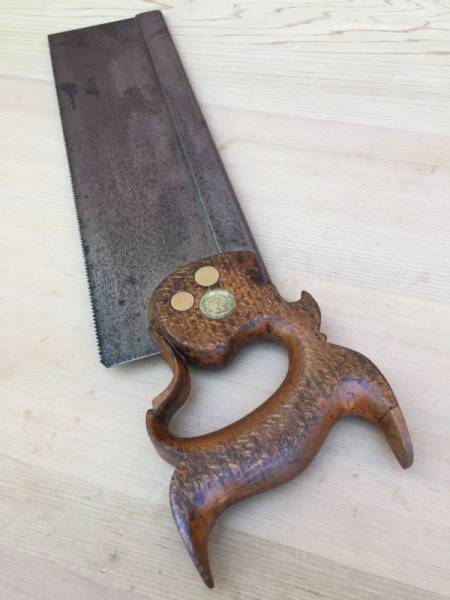
The one I played with looked exactly like this
...when it suddenly struck me...
Suppose you were keen to make an inexpensive saw which the woodworker was expected to modify to fit his or her hand perfectly. If that was your goal, wouldn't you make your saw's handle look exactly like this?
Likewise, if you wanted to make the blade such that the woodworker could adjust the set https://www.youtube.com/watch?v=13C5MWTKfwE (the amount of offset applied to the teeth to keep the saw plate from binding in the wood) to their preference, wouldn't you make the blade so that the modification was in the "easy" direction - i.e., taking the set out rather than putting it in?
It's my belief that these saws are made with the intention that they be modified by the end user; and if so, it's pretty clever on the part of Spear & Jackson - an example of "being lazy in the right direction." This belief is reinforced by a comment of a fellow in a Facebook woodworking group who said he used just such a saw in trade school, where one would expect such modification to be part of the curriculum.
I haven't begun modifying the handle of either saw, and I'm not going to do a thing to the blade of the larger panel saw - I quite like how it cuts. But the first thing I did when the tenon saw arrived was take some of the "set" out, then resharpen and true-up the teeth.
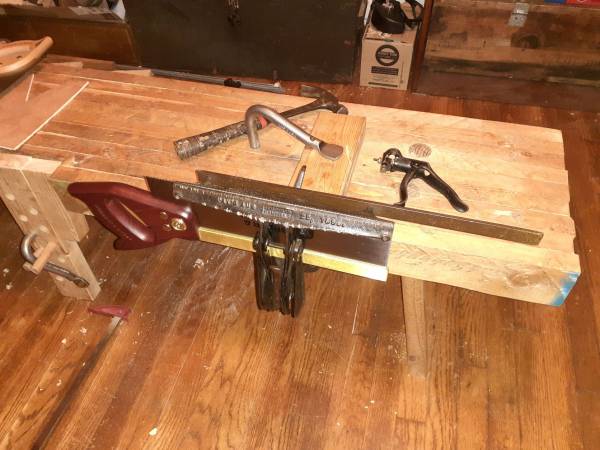
Sharpening a hand saw isn't difficult, and you don't need this special vise - two tomato stakes and a couple clamps will do the trick.
Here's a picture of the Spear & Jackson saw that arrived today, with the Disston saw I got earlier in the week for comparison's sake:
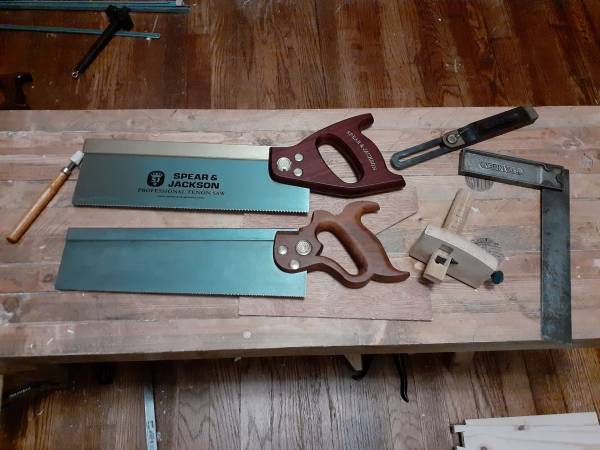
Also for comparison's sake, while the Spear & Jackson saw cost me about $40, the Disston - which is unarguably a better saw - cost me $175. It's Worth Every Penny, but I can't justify such extravagance too terribly often.
They're similar in size and teeth-per-inch, but the Disston's plate is thinner. I did not measure the set of the Spear & Jackson before I began taking out the set using the method shown in the videos above; however, I did do some test cuts and measured the two saws after I'd finished with the Spear & Jackson.
DISSTON:
SPEAR & JACKSON:
The photo of the cuts shows the progression of the kerf through two iterations of "un-setting," sharpening and stoning.
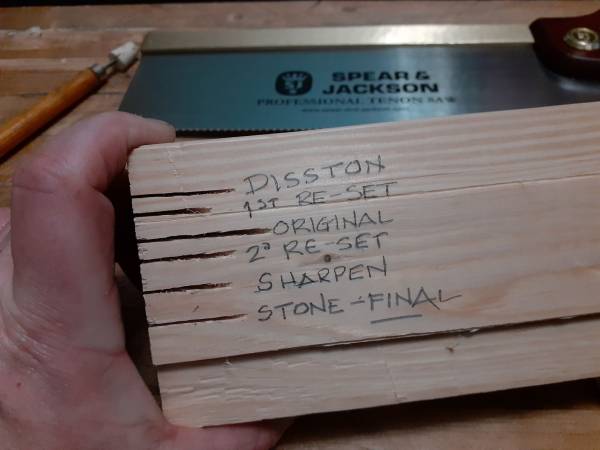
I'm completely satisfied with this saw. What I did with it also shows how a bit of simple work can bring the potential out of an otherwise mediocre & homely tool.
The handle will have to wait until I'm finished with the project seen lying on the floor in the first photo.
For perspective's sake, the saw on the bottom is what passed for a back saw at Chez GVI until just this week.
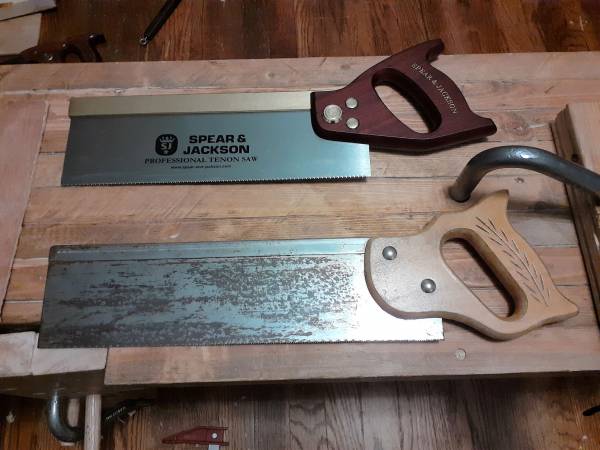
It's hard to overstate just how bad the bottom saw is
It's a piece-of-crap no-name thing that came with a miter box (wood or plastic , I can't remember) from a big-box hardware store about 20 years ago, and I've been using it - or rather, trying to avoid using it - ever since. It doesn't track straight, which is the ONE thing a backsaw ought to do; it binds annoyingly; and because of the tiny teeth and wavy nature of the crummy blade (it's more like a fat hacksaw than a tenon saw), you can't sharpen it or adjust the set to suit you.
It's going in the Goodwill or Church Rummage Sale box, and good riddance. It's why I consider the Spear & Jackson such an improvement.
GVI
www.alpharubicon.com
All materials at this site not otherwise credited are Copyright © 1996 - 2023 Trip Williams. All rights reserved. May be reproduced for personal use only. Use of any material contained herein is subject to stated terms or written permission.